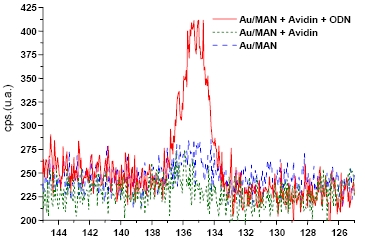

Fig. 1 : XPS spectra of phosphorus 2p levels recorded on the reference pMAN (blue), after avidin fixation (green), and after avidin fixation plus biotin-ODN (red).
Electrografting is a powerful technique that allows true chemical modification of conducting and semi-conducting surfaces. [1] Indeed, injecting electrons from the bulk material towards a solution of suitable electroactive molecules leads to the formation of activated moieties in the vicinity of the electrode, which eventually form strong chemical links with the electrode.
Our group has historically been developing the electrografting of vinylic polymers via an electro-induced anionic polymerization that starts from a precursor chemically bound to the electrode.
Strong efforts were devoted in past years both to the theoretical interpretation of the mechanism and towards practical applications of the process. That latter approach was rewarded in 2001 by the creation of a spin-off company, Alchimer, which applies the process in the biomedicine and microelectronics fields. [2-13]
From that moment, our group carried on support activities to develop and enrich the electrografting process. We first demonstrated that biological moieties can be directly immobilized on electrografted polymethacrylonitrile films via a spontaneous reaction between the nitrile groups from the film and the amino groups from the amino acids of the protein, in alcoholic basic medium. The formation of the resulting imino-ethers groups was followed by XPS measurements and assessed by high precision calculations of core electron binding energies. The final protein film is stable toward aqueous rinsing and can be used for protein-substrate recognition. [14]
More recently, we demonstrated that the simultaneous polymerization of two different vinylic monomers can be obtained by electrografting. We studied several couples of monomers chosen among four molecules: acrylonitrile, methacrylonitrile, methyl methacrylate and glycidyl methacrylate. In order to achieve simultaneous electrografting of both monomers, it is necessary to take into account the following molecular parameters: (i) the respective reduction potentials of the two monomers, (ii) the relative nucleophilicity of the anions propagating the reaction, (iii) the molecular structure of the neutral molecules. The influence of those parameters was discussed thanks to cyclic voltammetry, chronoamperometry, infrared measurements and quantum chemistry computational calculations. [15]
REFERENCES:
[1] Molecule-to-Metal Bonds: Electrografting Polymers on Conducting Surfaces,
S. Palacin, C. Bureau, J. Charlier, G. Deniau, B. Mouanda, P. Viel, ChemPhysChem 5(10), (2004) 1468;
[2] C. Bureau et al., Patent US20050170195 A1, 04/04/2005
[3] C. Bureau et al., Patent US20050255631 A1, 25/02/2005
[4] C. Bureau et al., Patent US7119030 B2, 17/11/2005
[5] P. Viel et al., Patent US20060141156 A1, 12/08/2005
[6] C. Bureau et al., Patent EP1687463 A1, 28/09/2004
[7] C. Bureau et al., Patent EP1543080 A2, 25/08/2003
[8] P. Viel et al., Patent EP1595001 A1, 13/02/2004
[9] C. Bureau et al., Patent US20040082120 A1, 08/07/2003
[10] C. Bureau et al., Patent EP1490444 A1, 19/03/2003
[11] C. Bureau et al., Patent EP1532197 A2, 25/08/2003
[12] C. Bureau et al., Patent FR0311494, 01/10/2003
[13] P. Viel et al., Patent FR0301874, 17/02/03
[14] Study of the simultaneous electro-initiated anionic polymerization of vinylic molecules
G. Deniau, J. Charlier, B. Alvado, S. Palacin, P. Aplincourt and C. Bauvais,J. Electroanal. Chem., 586(1) (2006) 62.
[15] Immobilization of Biomolecules on Electrodes Modified by Electrografted Films, S. Ameur, C. Bureau, J. Charlier, S. Palacin, J. Phys. Chem. B, 108(34) (2004) 13042.
•  Synthèse et caractérisation des nano-objets / Synthesis and characterization of nano-objects › From molecules to molecular materials
Synthèse et caractérisation des nano-objets / Synthesis and characterization of nano-objects › From molecules to molecular materials
• Laboratory of Physics and Chemistry of Surfaces and Interfaces • UMR 3685 NIMBE : Nanosciences et Innovation pour les Matériaux, la Biomédecine et l'Énergie • Service de Physique et Chimie des Surfaces et des Interfaces
• Laboratory of Chemistry of Surfaces and Interfaces (LCSI) • Laboratoire d'Innovation en Chimie des Surfaces et Nanosciences (LICSEN) • Laboratoire Innovation, Chimie des Surfaces Et Nanosciences- LCSI (LICSEN-LCSI)











